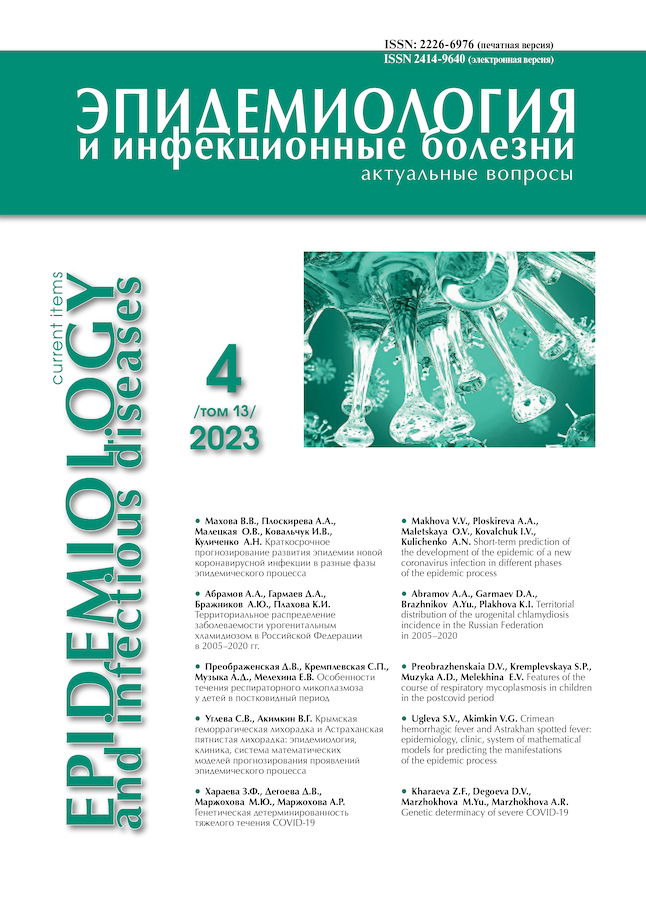Short-term prediction of the development of the epidemic of a new coronavirus infection in different phases of the epidemic process
- Autores: Makhova V.V.1, Ploskireva A.A.2, Maletskaya O.V.1, Kovalchuk I.V.3, Kulichenko A.N.1
-
Afiliações:
- Stavropol Research Anti-Plague Institute of Russian Federal Service for Supervision of Consumer Rights Protection and Human Well-Being
- Central Research Institute of Epidemiology of Russian Federal Service for Supervision of Consumer Rights Protection and Human Well-Being
- Department of Russian Federal Service for Supervision of Consumer Rights Protection and Human Well-Being for the Stavropol Territory
- Edição: Volume 13, Nº 4 (2023)
- Páginas: 7-13
- Seção: Epidemic Situation
- URL: https://journals.eco-vector.com/2226-6976/article/view/625508
- DOI: https://doi.org/10.18565/epidem.2023.13.4.7-13
- ID: 625508
Citar
Texto integral
Resumo
Objective. Testing an original method for short-term prediction of the epidemiological situation for COVID-19 using the example of the Stavropol Territory.
Materials and methods. We used data from the Department of Russian Federal Service for Supervision of Consumer Rights Protection and Human Well-Being in the Stavropol Territory, the «Center for Hygiene and Epidemiology in the Stavropol Territory» on cases of COVID-19 from March 20, 2020 to August 1, 2022, as well as the results of molecular genetic monitoring of fragmentary and whole-genome sequencing of clinical material from patients COVID-19 in the Stavropol Territory, received at the Stavropol Anti-Plague Institute of Russian Federal Service for Supervision of Consumer Rights Protection and Human Well-Being. We used the original short-term prediction method proposed by A.A. Ploskireva.
Results. The results of a retrospective analysis of the epidemic situation regarding COVID-19 in the Stavropol Territory in four periods (21.09–04.10.2020; 08–21.04.2021; 28.09–11.10.2021 и 01–14.04.2022) justified the median prediction scenario, in one (10–23.02.2022) – optimistic prediction scenario (P > 0.05). However, during the period of change from the SARS-CoV-2 «India» strain Delta B.1.617.2 to Omicron B.1.1.529, against the background of an increase in the number of vaccinated people, none of the prediction scenarios came true – the incidence during this period was lower than the pessimistic scenario.
Conclusion. The predicting technique can be used not only to predict a pandemic of a new coronavirus infection, but also to control and assess the spread of diseases from the group of new infections at different stages of the epidemic process in the short term.
Palavras-chave
Texto integral
Sobre autores
Valentina Makhova
Stavropol Research Anti-Plague Institute of Russian Federal Service for Supervision of Consumer Rights Protection and Human Well-Being
Autor responsável pela correspondência
Email: dr.makhova@yandex.ru
ORCID ID: 0000-0003-2988-3559
Junior Researcher, Laboratory of Epidemiology
Rússia, StavropolAntonina Ploskireva
Central Research Institute of Epidemiology of Russian Federal Service for Supervision of Consumer Rights Protection and Human Well-Being
Email: antoninna@mail.ru
ORCID ID: 0000-0002-3612-1889
MD, Professor, Deputy Director for Clinical Work
Rússia, MoscowOlga Maletskaya
Stavropol Research Anti-Plague Institute of Russian Federal Service for Supervision of Consumer Rights Protection and Human Well-Being
Email: maletskaya_ov@mail.ru
ORCID ID: 0000-0002-3003-4952
MD, Professor, Deputy Director for Scientific and Anti-epidemic Work
Rússia, StavropolIrina Kovalchuk
Department of Russian Federal Service for Supervision of Consumer Rights Protection and Human Well-Being for the Stavropol Territory
Email: kovalchuk_iv@26.rospotrebnadzor.ru
Cand. Med. Sci., Deputy Head
Rússia, StavropolAleksandr Kulichenko
Stavropol Research Anti-Plague Institute of Russian Federal Service for Supervision of Consumer Rights Protection and Human Well-Being
Email: kulichenko_an@list.ru
ORCID ID: 0000-0002-9362-3949
MD, Professor, Director
Rússia, StavropolBibliografia
- Кутырев В.В., Попова А.Ю., Смоленский В.Ю., Ежлова Е.Б., Демина Ю.В., Сафронов В.А. и др. Эпидемиологические особенности новой коронавирусной инфекции (COVID-19). Сообщение 1. Модели реализации профилактических и противоэпидемических мероприятий. Проблемы особо опасных инфекций 2020; (1): 6–13. doi: 10.21055/0370- 1069-2020-1-6-13. Kutyrev V.V., Popova A.Yu., Smolensky V.Yu., Ezhlova E.B., Demina Yu.V., Safronov V.A. et al. [Epidemiological features of the new coronavirus infection (COVID-19). Message 1. Models for the implementation of preventive and anti-epidemic measures]. Problems of Particularly Dangerous Infections 2020; (1): 6–13. (In Russ.). doi: 10.21055/0370-1069-2020-1-6-13
- WHO Coronavirus (COVID-19) Dashboard. https://covid19.who.int/
- Временные методические рекомендации «Профилактика, диагностика и лечение новой коронавирусной инфекции (COVID 19)». Версия 11. https://base.garant.ru/400738625/ [Interim guidelines on Prevention «Prevention, Diagnosis and Treatment of Novel Coronavirus Infection (COVID-19)». Version 11]. (In Russ.). https:// base.garant.ru/400738625/
- Huang C., Wang Y., Li X., Ren L., Zhao J., Hu Y. et al. Clinical features of patients infected with 2019 novel coronavirus in Wuhan, China. Lancet 2020; 395(10223): 497–506. https://doi.org/10.1016/S0140-6736(20)30183-5
- Onder G., Rezza G., Brusaferro S. Case-fatality rate and characteristics of patients dying in relation to COVID-19 in Italy. JAMA 2020; 323(18): 1775–6. https://doi.org/10.1001/jama.2020.4683
- Mehta P., McAuley D.F., Brown M., Sanchez E., Tattersall R., Manson J.J. et al. COVID-19: consider cytokine storm syndromes and immunosuppression. Lancet 2020; 395(10229): 1033–4. https://doi.org/10.1016/S0140-6736(20)30628-0
- Hollander J.E., Carr B.G. Virtually perfect? Telemedicine for COVID-19. N. Engl. J. Med. 2020; 382(18): 1679–81. https://doi.org/10.1056/NEJMp 2003539.
- Гаврилов Д.В., Абрамов Р.В., Кирилкина А.В., Ившин А.А., Новицкий Р.Э. Модель прогнозирования пандемии COVID-19 на основе машинного обучения в отдельных регионах Российской Федерации. Фармакоэкономика. Современная фармакоэкономика и фармакоэпидемиология 2021; 14(3): 342–56. https://doi.org/10. 17749/2070-4909/farmakoekonomika.2021.108. Gavrilov D.V., Abramov R.V., Kirilkina A.V., Ivshin A.A., Novitsky R.E. [A model for predicting the COVID-19 pandemic based on machine learning in certain regions of the Russian Federation]. Pharmacoeconomics. Modern pharmacoeconomics and pharmacoepidemiology 2021; 14(3): 342–56. (In Russ.). https://doi.org/10.17749/2070-4909/farmakoekonomika. 2021.1081
- Антонец Д.В., Плоскирева А.А., Поспелов М.В., Смоленский В.Ю. Комплексный анализ и прогноз развития эпидемиологической ситуации по COVID-19 в Российской Федерации (2020-08-31). doi: 10.21055/preprints-3111803. Antonets D.V., Ploskireva A.A., Pospelov M.V., Smolensky V. Yu. [Comprehensive analysis and forecast of the development of the epidemiological situation on COVID-19 in the Russian Federation (2020-08-31)]. (In Russ.). doi: 10.21055/preprints-3111803.
Arquivos suplementares










